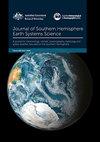ACCESS-S1新的气象局多周季节预报系统
IF 3.6
4区 地球科学
Q1 Earth and Planetary Sciences
引用次数: 0
摘要
ACCESS-S1将是澳大利亚气象局季节预报系统的下一个版本,预计将于2018年初投入使用。ACCESS-S1的多周和季节性表现基于23年的预测集进行了评估,并与当前的操作系统POAMA进行了比较。与POAMA相比,该系统有相当大的增强,包括组件模型的更高垂直和水平分辨率以及最先进的物理参数化方案。ACCESS-S1基于英国气象局GloSea5-GC2季节预报系统,但对集合生成策略进行了增强,使其适合多周预报和更大的集合规模。与POAMA相比,ACCESS-S1显著减少了全球和澳大利亚平均气候状态的偏差。ACCESS-S1还能更好地预测El Niño南方涛动发展的早期阶段(通过可预测性障碍)和印度洋偶极子,以及南环模和马登-朱利安涛动的多周变化,这些都是澳大利亚气候变化的重要驱动因素。与POAMA相比,澳大利亚在多周时间尺度上的降雨、最高温度(Tmax)和最低温度(Tmin)预报技术有了全面的提高。在季节时间尺度上,两种系统之间的差异通常不太明显。与POAMA相比,ACCESS-S1改进了澳大利亚南部春季的季节性预报,对降雨量和Tmax的预报可靠性特别好。然而,与POAMA相比,对澳大利亚东部地区秋末和冬季季节平均Tmax的预测明显不那么熟练。该研究确定了未来ACCESS-S的改进范围,特别是1)减少印度洋和海洋大陆地区的降雨误差,以及2)用实际土壤湿度而不是气候学初始化陆地表面。后者会对澳大利亚东部的温度预报产生负面影响,并将在系统的下一个版本ACCESS-S2中得到解决。本文章由计算机程序翻译,如有差异,请以英文原文为准。
ACCESS-S1 The new Bureau of Meteorology multi-week to seasonal prediction system
ACCESS-S1 will be the next version of the Australian Bureau of Meteorology's seasonal prediction system, due to become operational in early 2018. The multiweek and seasonal performance of ACCESS-S1 has been evaluated based on a 23-year hindcast set and compared to the current operational system, POAMA. The system has considerable enhancements compared to POAMA, including higher vertical and horizontal resolution of the component models and state-ofthe-art physics parameterisation schemes. ACCESS-S1 is based on the UK Met Office GloSea5-GC2 seasonal prediction system, but has enhancements to the ensemble generation strategy to make it appropriate for multi-week forecasting, and a larger ensemble size.ACCESS-S1 has markedly reduced biases in the mean state of the climate, both globally and over Australia, compared to POAMA. ACCESS-S1 also better predicts the early stages of the development of the El Niño Southern Oscillation (through the predictability barrier) and the Indian Ocean Dipole, as well as multi-week variations of the Southern Annular Mode and the Madden-Julian Oscillation — all important drivers of Australian climate variability. There is an overall improvement in the skill of the forecasts of rainfall, maximum temperature (Tmax) and minimum temperature (Tmin) over Australia on multi-week timescales compared to POAMA. On seasonal timescales the differences between the two systems are generally less marked. ACCESS-S1 has improved seasonal forecasts over Australia for the austral spring season compared to POAMA, with particularly good forecast reliability for rainfall and Tmax. However, forecasts of seasonal mean Tmax are noticeably less skilful over eastern Australia for forecasts of late autumn and winter compared to POAMA.The study has identified scope for improvement of ACCESS-S in the future, particularly 1) reducing rainfall errors in the Indian Ocean and Maritime Continent regions, and 2) initialising the land surface with realistic soil moisture rather than climatology. The latter impacts negatively on the skill of the temperature forecasts over eastern Australia and is being addressed in the next version of the system, ACCESS-S2.
求助全文
通过发布文献求助,成功后即可免费获取论文全文。
去求助
来源期刊

Journal of Southern Hemisphere Earth Systems Science
Earth and Planetary Sciences-Oceanography
CiteScore
8.10
自引率
8.30%
发文量
0
审稿时长
>12 weeks
期刊介绍:
The Journal of Southern Hemisphere Earth Systems Science (JSHESS) publishes broad areas of research with a distinct emphasis on the Southern Hemisphere. The scope of the Journal encompasses the study of the mean state, variability and change of the atmosphere, oceans, and land surface, including the cryosphere, from hemispheric to regional scales.
general circulation of the atmosphere and oceans,
climate change and variability ,
climate impacts,
climate modelling ,
past change in the climate system including palaeoclimate variability,
atmospheric dynamics,
synoptic meteorology,
mesoscale meteorology and severe weather,
tropical meteorology,
observation systems,
remote sensing of atmospheric, oceanic and land surface processes,
weather, climate and ocean prediction,
atmospheric and oceanic composition and chemistry,
physical oceanography,
air‐sea interactions,
coastal zone processes,
hydrology,
cryosphere‐atmosphere interactions,
land surface‐atmosphere interactions,
space weather, including impacts and mitigation on technology,
ionospheric, magnetospheric, auroral and space physics,
data assimilation applied to the above subject areas .
Authors are encouraged to contact the Editor for specific advice on whether the subject matter of a proposed submission is appropriate for the Journal of Southern Hemisphere Earth Systems Science.
 求助内容:
求助内容: 应助结果提醒方式:
应助结果提醒方式:


